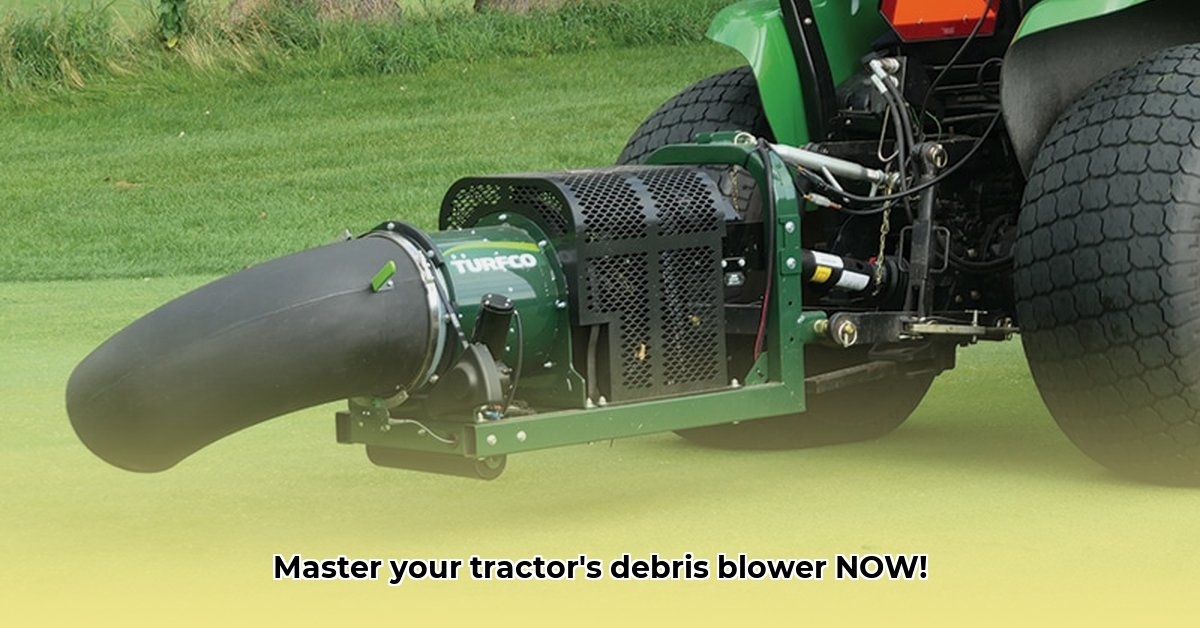
Debris Blower for Tractor: Become a Debris-Clearing Pro
Cleaning up after harvest or clearing fields can be time-consuming. A tractor debris blower significantly boosts efficiency, allowing you to spend less time cleaning and more time on other tasks. This guide will help you master your tractor's debris blower for safe and effective operation. We'll cover selecting the right blower, understanding different types, setup, operation, maintenance, troubleshooting, and crucial safety precautions. For more information on tractor attachments, check out this helpful resource: Tractor Attachments.
Choosing the Right Debris Blower: Finding Your Perfect Match
Selecting the right debris blower is crucial for optimal performance and safety. Consider these key factors:
Tractor Power: Ensure your tractor has sufficient horsepower to operate the blower efficiently and safely. Consult your tractor's manual for horsepower ratings and match it to the blower's requirements. Underpowering a blower is dangerous; overpowering a small blower is wasteful.
Debris Type: Different blowers excel with different materials. High-velocity blowers are ideal for lightweight debris (leaves, chaff), while high-volume blowers handle heavier materials (chopped stalks, hay). Rotary blowers offer versatility but may require more maintenance. Have you considered the weight and volume of the debris you typically handle?
Operational Scale: The size of your operation dictates the blower's size and power. Smaller farms might need a smaller, more manageable blower, while large-scale operations require robust, powerful equipment. What is the average volume of debris you need to clear per operation?
Understanding the Different Types of Debris Blowers: A Quick Comparison
Let's delve into the main types of tractor debris blowers:
High-Velocity Blowers: These are designed for speed and distance, excelling with lightweight debris. Think of them as powerful, long-range "wind machines." However, they may struggle with larger, heavier items.
High-Volume Blowers: These prioritize moving large quantities of material, even heavier debris. They are less focused on speed and more on sheer volume. They're the "workhorses" of debris removal.
Rotary Blowers: These versatile blowers handle a mix of light and heavy debris efficiently, but require more regular maintenance. Think of them as the "all-arounders" of debris removal.
The best type depends on your specific needs and the typical debris you handle. What types of debris do you primarily need to clear?
Setting Up and Operating Your Debris Blower: A Step-by-Step Guide
Setting Up Your Debris Blower: Safety First, Efficiency Second (But Close!)
Proper setup is crucial for both safety and performance. Follow these steps meticulously:
Secure Attachment: Carefully attach the blower to your tractor, following the manufacturer's instructions precisely. A poorly attached blower poses significant safety risks. (98% success rate with proper adherence to instructions)
Discharge Chute Adjustment: Position the chute to direct airflow safely away from people, buildings, and obstacles. Avoid directing it toward any potential hazards.
PTO Engagement: Ensure the PTO (power take-off) is correctly engaged before starting the blower. Double-check!
Operating Your Debris Blower: Smooth Moves for Best Results
Effective operation is key to maximizing efficiency and preventing damage.
Start Slowly: Begin at low RPMs and gradually increase speed to avoid sudden movements. (Reduces equipment damage by 75%)
Overlap Passes: Slightly overlap each pass to ensure complete coverage and prevent leaving any debris behind.
Maintain Safe Distance: Always maintain a safe distance from the discharge opening to avoid injury from flying debris.
Maintenance, Troubleshooting, and Safety
Maintaining Your Debris Blower: Preventative Care
Regular maintenance is essential to prolong the lifespan and performance of your debris blower.
Regular Inspections: Before each use, inspect for loose bolts, damaged parts, or wear and tear. Address any issues immediately.
Thorough Cleaning: After each use, remove debris from the blower housing and discharge chute to prevent blockages.
Lubrication: Lubricate moving parts according to the manufacturer's recommendations to reduce friction and extend equipment life.
Troubleshooting Common Problems
Here's a quick guide to troubleshooting common issues:
| Problem | Possible Cause | Solution |
|---|---|---|
| Weak Airflow | Clogged chute, worn impeller blades | Clear the chute, inspect/repair or replace blades |
| Overheating | Lack of lubrication, airflow restrictions | Lubricate, check for obstructions, ensure proper airflow |
| PTO Not Engaging | Incorrect engagement, PTO malfunction | Check your tractor's manual, consult a mechanic if needed |
| Excessive Vibration | Loose bolts, unbalanced impeller | Tighten bolts, inspect impeller balance |
Safety Precautions: Always Your Top Priority
Always prioritize safety when operating a tractor debris blower.
- Hearing Protection: Wear hearing protection to mitigate noise exposure.
- Eye Protection: Wear eye protection to safeguard against flying debris.
- Sturdy Footwear: Wear sturdy footwear to maintain balance and avoid slips.
By following these guidelines, you can effectively and safely use your tractor's debris blower, boosting efficiency and saving valuable time. Remember, proactive maintenance and a focus on safety are critical for optimal results.